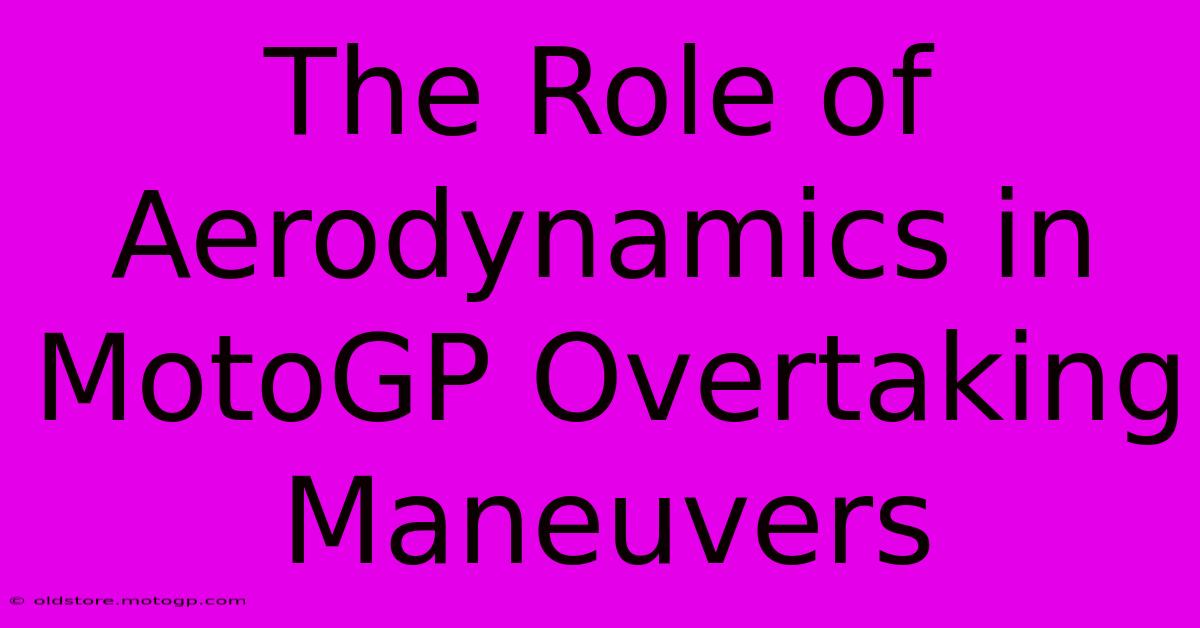The Role Of Aerodynamics In MotoGP Overtaking Maneuvers

Table of Contents
The Role of Aerodynamics in MotoGP Overtaking Maneuvers
MotoGP racing is a thrilling spectacle of speed, skill, and strategy. Overtaking maneuvers, often executed at breakneck speeds, are pivotal moments that decide races. While rider skill is paramount, the intricate role of aerodynamics in facilitating – or hindering – these maneuvers is often overlooked. This article delves into the significant impact of aerodynamics on overtaking in MotoGP.
Understanding Aerodynamic Forces in MotoGP
Before we explore overtaking, understanding the fundamental aerodynamic forces acting on a MotoGP bike is crucial. These bikes are designed to generate downforce – the force pushing the bike towards the track – and reduce drag – the resistance to forward motion. This balance is meticulously engineered to achieve optimal performance. Key aerodynamic components include:
- Fairings: The sculpted bodywork of the bike, strategically designed to manage airflow and generate downforce.
- Wings: These prominent appendages, often located on the fairing and swingarm, contribute significantly to downforce, especially at high speeds.
- Aerodynamic Appurtenances: Smaller elements, such as winglets, spoilers, and diffusers, fine-tune airflow and enhance downforce generation or drag reduction.
Downforce: The Overtaking Enabler
Downforce is crucial for overtaking. Increased downforce provides superior grip and stability, allowing riders to brake later, accelerate harder out of corners, and maintain higher speeds through turns. This translates to:
- Improved braking stability: More downforce means better tire contact with the track, allowing for more aggressive braking without losing control – essential for close-quarters overtaking.
- Enhanced cornering speed: The increased grip allows riders to carry more speed through corners, enabling them to maintain a tighter racing line and making it harder for opponents to pass.
- Quicker acceleration: The improved traction facilitates quicker acceleration out of corners, crucial for completing an overtake decisively.
Drag: The Overtaking Obstacle
While downforce is advantageous, drag is the enemy of overtaking. Drag reduces a bike's top speed and acceleration. A bike with high drag needs more power to maintain speed, hindering the ability to accelerate past opponents, particularly on straights. Therefore, MotoGP engineers strive to minimize drag while maximizing downforce. This is a constant balancing act, as changes made to increase downforce often increase drag as well.
Aerodynamics and Overtaking Techniques
The interaction between a bike's aerodynamics and the rider's overtaking techniques is complex. Different overtaking strategies benefit from different aerodynamic setups:
- Slipstreaming: Riding closely behind another bike reduces drag, allowing the trailing rider to gain speed. This tactic often sets up an overtake on the straights, where aerodynamic efficiency is paramount.
- Cornering Overtakes: These are often more challenging due to the reduced speed and increased importance of braking and traction. Downforce plays a pivotal role here, enabling a rider to maintain higher cornering speeds and brake later, allowing them to outmaneuver their opponent.
- Drafting and the "tow": Clever use of slipstreaming and the aerodynamic wake of the leading bike can give the trailing rider significant advantages in speed and acceleration, making an overtake possible that might otherwise be impossible.
The Constant Evolution of MotoGP Aerodynamics
MotoGP aerodynamics are constantly evolving. Teams invest heavily in wind tunnel testing and Computational Fluid Dynamics (CFD) simulations to optimize their bikes for maximum downforce and minimal drag. Regulation changes frequently impact the design of aerodynamic components, resulting in a continuous arms race for aerodynamic supremacy. This constant innovation is a key driver in the ever-increasing speeds and thrilling overtaking maneuvers we witness in MotoGP.
Conclusion: Aerodynamics, a Silent but Crucial Player
The role of aerodynamics in MotoGP overtaking maneuvers is undeniable. While rider skill remains the ultimate factor, the ability to generate sufficient downforce and minimize drag provides a significant competitive advantage, impacting braking, cornering, and acceleration – all crucial elements in successful overtaking. As technology continues to advance, the importance of aerodynamics in shaping the thrilling spectacle of MotoGP will only continue to grow.

Thank you for visiting our website wich cover about The Role Of Aerodynamics In MotoGP Overtaking Maneuvers. We hope the information provided has been useful to you. Feel free to contact us if you have any questions or need further assistance. See you next time and dont miss to bookmark.
Featured Posts
-
Fuel Your Passion F1 Austin 2025
Feb 18, 2025
-
Moto Gps Sprint Races Dont Miss The Action
Feb 18, 2025
-
Moto Gp On Tnt Sports Every Race Every Time
Feb 18, 2025
-
Motorcycle Helmet Replicas Designed For Performance
Feb 18, 2025
-
From Zero To Hero Moto Gp Classification Climbers
Feb 18, 2025
